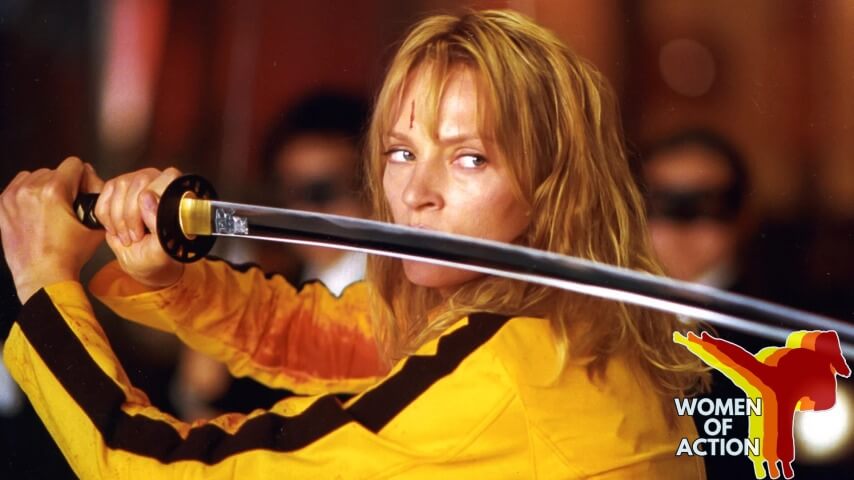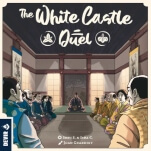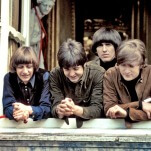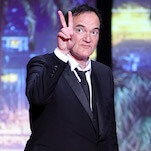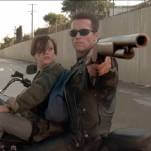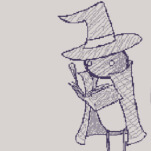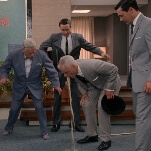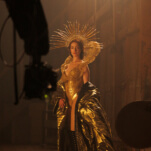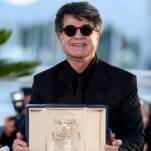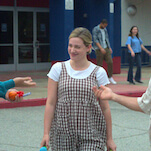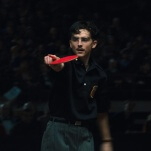With Women Of Action, Caroline Siede digs into the history of women-driven action movies to explore what these stories say about gender and how depictions of female action heroes have evolved over time.
When I launched a column about women-led action movies, I knew I’d tackle Quentin Tarantino eventually. But I didn’t expect he’d come up so much in my research for other films. Michelle Yeoh credits him with saving her action career after a brutal injury on The Stunt Woman left her contemplating walking away from the genre altogether—he literally visited her in the hospital in Hong Kong to tell her how much her work meant to him. And at a time when the legendary Pam Grier was struggling to even get supporting roles, Tarantino used his Pulp Fiction clout to cast her as the titular hero of his third film, Jackie Brown—her first lead role in 22 years.
When it comes to female action stars, Tarantino’s fandom seems quite sincere. And that’s one more piece of the puzzle when it comes to grappling with a director whose work I generally enjoy, but who I also remain skeptical of. When you’re a female film buff, you make your peace with the fact that there are some male directors you can trust to craft compelling female characters (Ryan Coogler, Pedro Almodóvar) and others who just aren’t hugely interested in the interior lives of women (Christopher Nolan, Martin Scorsese). But the trickiest category to wrestle with are the male filmmakers who showily proclaim their love for strong female characters but don’t always back it up in their work—writer-directors like James Cameron, Joss Whedon, and Tarantino.
When Nolan writes another dead wife movie, it’s not particularly shocking. But when the man who gave us The Terminator gives us True Lies or the man who gave us Black Widow in The Avengers gives us Black Widow in Avengers: Age Of Ultron, it’s a betrayal. (That’s not even getting into the lengthy workplace abuse allegations against Whedon, which is a separate, but not entirely unrelated, issue.) Tarantino is one of those filmmakers where you can never quite tell whether he’s going to deliver one of his patented spitfire heroines or turn domestic abuse into a punchline.
Given all that, maybe it’s fitting that Tarantino’s most iconic female character—Uma Thurman’s Beatrix “The Bride” Kiddo—comes from a film steeped in the history of 1970s exploitation cinema; the revenge thrillers, martial arts imports, Blaxploitation flicks, women-in-prison films, and spaghetti Westerns that were filmed and released on the cheap as the traditional Hollywood studio system began to crumble. Tarantino wanted to do for ’70s grindhouse cinema what Raiders Of The Lost Ark did for movie serials of the 1930s and ’40s. As with the films of Grier and her contemporaries, that means both empowerment and fetishization are in the mix.
That tension could also be because Kill Bill was very much a joint venture between Tarantino and Thurman. They dreamed up the project together during Pulp Fiction, while the cast and crew were out for drinks. Over a game of miniature shuffleboard, they started spitballing ideas about a pregnant female assassin who gets attacked at her wedding, loses her baby, and goes on a revenge quest. Tarantino was so excited by the concept, he went home and wrote nine pages of the script that night. (The film ends with the credit “Based on the character of ‘The Bride,’ created by Q & U.”)
It would be nearly a decade before the film actually came together, however, after Thurman and Tarantino ran into each other at a party and she asked whatever happened to those pages. The time off fundamentally changed the nature of the project. “If I had written it [during Pulp Fiction], I probably would have based it on the Uma of that time: a 22-year-old girl,” Tarantino told IGN. Instead, he spent a year and a half working on the script while getting to re-know Thurman as a thirtysomething mother. He’d write pages, she would read them, and they’d talk through the story together—all while he took more and more inspiration from her life as a mom. By the time Tarantino actually finished the script, Thurman was pregnant with her second kid, and Tarantino pushed back production to wait for her. As he put it, “Would Sergio Leone have replaced Eastwood in A Fistful Of Dollars? Would von Sternberg have replaced Dietrich in Morocco? I knew how good she was going to be in this movie, so we waited.”
Though Kill Bill is often credited as a trailblazing film for female action heroes, that’s really only half true. During the ’80s and ’90s, Ripley and Sarah Connor had proven that women could open action blockbusters. And by the time the first Kill Bill movie premiered in 2003, we were well into a wave of late ’90s/early aughts “girl power” projects. TV shows like Xena: Warrior Princess, Buffy The Vampire Slayer, and The Powerpuff Girls paved the way for movies like Mulan, Charlie’s Angels, Miss Congeniality, and Lara Croft: Tomb Raider.
But what Tarantino did do was bring grit and bloodshed back to the female-led action genre, with an R-rated film that decidedly wasn’t for the whole family. The Bride is far gnarlier than your average blockbuster heroine—slicing off people’s limbs, ripping out their eyeballs, and even (unintentionally) killing a mother in front of her child. While films like Resident Evil and Underworld were moving in that direction in a campier way, Tarantino’s auteur bona fides gave Kill Bill a prestige sheen.
The sheer amount of kickass women contained in one movie also felt like a novelty at the time. In terms of iconography alone, it’s no small feat for an action film to deliver five instantly recognizable Halloween costumes for women—including not just The Bride with her yellow Bruce Lee tracksuit and samurai sword, but also Vivica A. Fox’s Vernita Green, Daryl Hannah’s Elle Driver, Chiaki Kuriyama’s Gogo Yubari, and Lucy Liu’s O-Ren Ishii. It’s also no small feat that each of their respective showdowns with The Bride is in contention for the best fight scene in the saga. (Personally, the Vernita and Elle fights are my favorites.)
But by far the most compelling thing about Kill Bill is the code that The Bride and her fellow Deadly Viper Assassination Squad members operate under. In a cinematic landscape where female action heroes tend to be scrappy survivors or sexy double agents, Bill’s vipers offer something nobler. Beatrix brutally attacks Vernita in her own home, but instinctively agrees to shield Verinta’s daughter from the violence. Elle loathes Beatrix, yet remains adamant that she deserves a heroic death. O-Ren apologizes when she realizes she’s underestimated her foe. And, perhaps most moving of all, Beatrix tells Vernita’s daughter that she’ll understand if she one day grows up and seeks vengeance against her too. For all its overt homages to other films, giving these female assassins the moral code of a samurai or swashbuckler is a truly original twist for American action cinema.
For Tarantino, the project was a chance to prove he could do more than just make motormouthed crime movies. Particularly for the first half of the story (the film was originally envisioned as one long epic, before it was split into two films released six months apart), Tarantino decided to work almost exclusively in the action genre. He wanted the climactic House Of Blue Leaves showdown to be “one of the greatest, most exciting sequences in the history of cinema” and went six weeks beyond the initial two-week shooting schedule to get it right in all its bloody, over-the-top glory.
For Thurman, meanwhile, The Bride was a chance to give her the sort of signature lead role that her eclectic career was lacking. (She was coming off a run of rom-coms, period pieces, and action blockbuster failures like Batman & Robin and 1998’s The Avengers.) Just three months after giving birth, Thurman began training with legendary choreographer-director Yuen Woo-ping, who was just coming off his seismic work on The Matrix. She learned three styles of kung fu, two styles of sword fighting, knife throwing, hand-to-hand combat, and some Japanese to boot. But her focus was also on how to shape the character of The Bride in a film that wasn’t particularly deep on characterization. Tarantino told her to take inspiration from Hong Kong cinema and female-samurai movies—the 1973 Japanese film Lady Snowblood is the most direct inspiration—but Thurman “wanted to make something new.”
That meant “expanding the emotional universe of the character,” as Thurman told IGN in 2004. “In this case, it’s a very rich character but yet so streamlined and so physical and there’s so much less time for expression than your average drama or something. But that’s what we do, women, because our parts are always underwritten, actually, usually, so we kind of go in there and that’s what we do, is we try to take whatever we get and we fill it up and make something out of it.”
In fact, according to a 2003 Time profile, “director and actress argued almost daily about just how to portray the Bride, with Thurman lobbying (often successfully) for everything from wardrobe changes to dialogue rewrites. ‘Quentin’s actually kind of great to argue with,’ says Thurman. ‘He’s a tough character, but he’s not stupid, and he grants it when you score a point.'” As Thurman added, “He is brilliant, but my job was to take this character out of his wildly creative, seemingly improvisational world and make her human. If the movie was going to be more than a cartoon, it was up to me.”
As the film’s non-linear structure unfolds, Thurman is fantastic at fleshing out Beatrix’s arc from excitable young girlfriend to dedicated student to pregnant woman on the run to vengeful assassin to “mommy,” once she learns that her daughter actually survived the attempt on her life. Beneath all the sound and fury of the film’s colorful action sequences, there’s a real humanity to Beatrix, particularly in the more contemplative, Western-inspired Volume 2. Thurman is steely in her fight scenes, but softer and bubblier at times too. It makes sense that everyone who meets her seems to instantly fall in love with her, even when they also want to kill her.
That all builds to the subversive finale, where she kills her ex-boss/lover Bill (David Carradine) not in a bloody reign of violence but in a quiet act of kung fu mastery. Especially considering how zany Volume 1 is, it’s impressive how much heart there is in the sequel; how truly cathartic it is to watch Beatrix get not just everything she wanted but even more than she ever dreamed.
And yet, I still find it hard to completely give myself over to Kill Bill. When people talk about exploitation or “the male gaze,” there’s a misconception that it’s solely about sexuality and nudity. But I’m far more frustrated by a film that misjudges what women find empowering than one that puts them in slinky catsuits. Take the scene where we learn that a male nurse at the hospital has been pimping out The Bride’s comatose body for the past four years. Tarantino seems to think that if he makes the rapists as cartoonishly evil as possible it’ll be that much more satisfying when she wakes up and kills them. (“Sometimes this chick’s cooch can get drier than a bucket of sand,” the nurse explains before handing over a tub of “Vasalube,” presumably to gales of laughter from the teenage boys in the audience.)
To me, the edgelord humor elides the horror of what’s going on, rather than adding to it. It suggests that Tarantino views rape as a fantastical movie threat—like getting your arm sliced off by a samurai sword—rather than a reality that so many women (including Thurman herself) have experienced. As I wrote about with Jennifer Lopez’s Enough, there can be something genuinely empowering about a woman getting vengeance on her abuser, even in a shlocky action flick. The difference is that Enough presents domestic abuse like a horror movie, while Kill Bill presents sexual assault like a joke; one we’re “allowed” to laugh at because The Bride is triumphant in the end.
While The Bride may not be overtly sexualized, the would-be rape scene still gives me the same sort of icky feeling as the sleazy sexual violence in Grier’s early vehicles. In that sense, I suppose Tarantino succeeded at homaging them. But to what end? It feels less like Tarantino is intentionally challenging the male gaze and more like his particular gaze is less conventional; rooted in bare feet and eroticized violence rather than boobs and butts.
There’s also the immense irony that this story of violent female empowerment was produced by Harvey Weinstein—who attacked Thurman in a hotel room during the mid-’90s after the success of Pulp Fiction. When she told Tarantino about the incident, he made Weinstein apologize to her before they all began working together again on Kill Bill (a pretty damning “solution”). As Thurman later reflected, “I am one of the reasons that a young girl would walk into his room alone, the way I did. Quentin used Harvey as the executive producer of Kill Bill, a movie that symbolizes female empowerment. And all these lambs walked into slaughter because they were convinced nobody rises to such a position who would do something illegal to you, but they do.”
Indeed, the legacy of Kill Bill comes with another asterisk after Thurman released video footage of a car crash that happened on set, with four days left of the nine-month shoot. Tarantino pressured her into filming a driving scene she wasn’t comfortable doing, resulting in a crash that landed her in the hospital with permanent neck damage and causing a years-long rift between director and actor. Tarantino says he regrets making her drive the car, but maintains that Thurman was more mad about Weinstein and his fellow producers covering up the incident than she was with him—which she called “dehumanization to the point of death.” (She later posted on Instagram saying she was proud of Tarantino “for doing the right thing.”)
Thurman put up with a lot throughout the shoot, including Tarantino personally spitting on her during a close-up shot and using his hands to film a scene where Gogo chokes her with a chain. (A move he’d repeat with Diane Kruger in Inglourious Basterds.) “What really got me about the crash was that it was a cheap shot,” Thurman explained. “I had really always felt a connection to the greater good in my work with Quentin and most of what I allowed to happen to me and what I participated in was kind of like a horrible mud wrestle with a very angry brother. But at least I had some say, you know? … When they turned on me after the accident, I went from being a creative contributor and performer to being like a broken tool.”
As Jessica Chastain pointed out when the story broke in 2018, there’s a long history of movies where the female protagonist only has her “phoenix” moment after she’s been beaten and raped—as if the abuse itself is what makes her powerful. She can’t seek revenge for someone else, like in Taken or John Wick. She must first go through hell in order to avenge herself. Kill Bill wants to have fun playing around with those tropes, but the irony is that The Bride’s “entertaining” and “empowering” story can play like a dark mirror image of Thurman’s behind-the-scenes experience.
Like Beatrix herself, Kill Bill is a messy, contradictory duology. It didn’t exactly inspire a wave of female-led revenge thrillers (Salt, Haywire, and Colombiana didn’t arrive until the 2010s), but still stands as a seismic part of the American action canon. There’s also no right answer on how to grapple with its legacy. But perhaps the best perspective comes from Thurman herself during the press tour in 2003: “I am really so happy with it. And so happy that it’s over.”
Next time: In 2012, The Hunger Games created a whole new style of action heroine.
